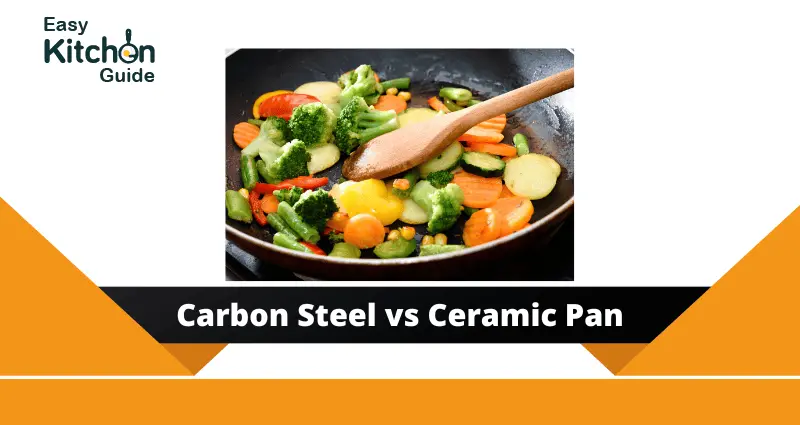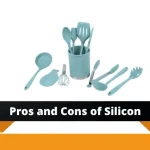In an era of culinary excellence, choosing carbon steel and ceramic pans can often leave home cooks in a dilemma. Carbon steel pans offer superior heat conductivity and durability, ideal for high-heat cooking techniques. Another hand, ceramic pans provide non-stick convenience and even heat distribution. These pans are perfect for low-fat cooking and delicate recipes. Both pans have unique advantages and considerations. Understanding their characteristics and best uses is essential. This article compares “Carbon Steel vs Ceramic Pan“, exploring features, benefits, and suitability for different cooking styles.
Comparison at a Glance:
Table of Contents,
Here’s a comparison table showcasing the manufacturing characteristics and heat responsiveness of Carbon Steel and Ceramic Pans:
| Aspect | Carbon Steel Pan | Ceramic Pan |
|---|---|---|
| Manufacturing Material | Carbon Steel | Ceramic |
| Manufacturing Process | Formed by shaping and welding carbon steel sheets | Clay or porcelain mixture molded and glazed |
| Heat Conductivity | High heat conductivity | Lower heat conductivity |
| Responsiveness to Heat | Very responsive to heat changes | Less responsive to heat changes |
| Heat Distribution | Provides even heat distribution throughout the surface | Heat distribution can be uneven |
| Thickness | Can be manufactured with varying thicknesses | Generally uniform thickness |
| Temperature Limitations | Can withstand high temperatures | Limited resistance to extreme temperature changes |
| Durability | Durable and long-lasting | Relatively fragile, can chip or crack over time |
| Maintenance | Requires seasoning and regular oiling for maintenance | Easy to clean and maintain |
| Price Range | Relatively affordable | Relatively fragile, it can chip or crack over time |
Carbon Steel Pans: The Versatile Workhorse

Carbon steel pans are popular among professional chefs and cooking enthusiasts for their exceptional heat conductivity and versatility. These pans are made from an alloy of iron and carbon, which offers several benefits:
Heat Conductivity:
Carbon steel pans heat up quickly and evenly, allowing precise temperature control. This property makes them ideal for searing, stir-frying, and achieving a perfect crust on meats.
Durability:
Carbon steel pans are known for their durability and can withstand high temperatures and frequent use. They develop a natural non-stick patina over time, enhancing their performance with proper care.
Lightweight and Maneuverability:
Unlike cast iron pans, carbon steel pans are relatively lightweight, making them easier to handle. They offer the benefits of durability without the bulk.
Ceramic Pans: The Non-Stick Wonder

Ceramic pans have gained attention for their non-stick properties and eco-friendly composition. Here are some notable features of ceramic pans:
Non-Stick Coating:
Ceramic pans are coated with a non-stick surface, making them excellent for low-fat cooking without the need for excessive oil or butter. They provide easy food release and effortless cleanup.
Health Considerations:
Ceramic pans are typically free from harmful chemicals like PFOA and PTFE, offering a safer cooking experience. They are a popular choice among health-conscious individuals.
Even Heat Distribution:
Ceramic pans take more time to heat. They retain heat for more time. This feature makes them unique for keeping meals hot even after cooking.
Carbon Steel vs Ceramic: Best Uses and Cooking Styles
To help you decide which pan is best suited for your cooking needs, let’s explore their specific uses:
Carbon Steel Pan Best Uses:
- Searing and browning meats: Carbon steel pans achieve perfect sear and caramelization due to their excellent heat conductivity.
- Stir-frying and sautéing: The even heat distribution of carbon steel pans allows for quick and efficient stir-frying and sautéing of vegetables and proteins.
- High-heat cooking techniques: Whether flash-frying or broiling, carbon steel pans can withstand high temperatures, making them ideal for various cooking methods.
Ceramic Pan Best Uses:
- Low-fat cooking: Ceramic pans’ non-stick coating allows for cooking with minimal oil or fat, making them suitable for health-conscious individuals.
- Delicate dishes: The even heat distribution of ceramic pans makes them perfect for cooking delicate recipes like omelettes, fish fillets, and pancakes.
- Simmering and slow cooking: Ceramic pans retain heat effectively, making them great for simmering soups, stews, and sauces.
Heat Responsiveness Differences between Carbon Steel and Ceramic Pans:
When it comes to heat responsiveness, Carbon Steel pans are known for their excellent heat conductivity and responsiveness. They heat up quickly and distribute heat evenly throughout the cooking surface. As a result, they respond rapidly to changes in temperature, allowing for precise control over cooking.
Ceramic pans, on the other hand, have lower heat conductivity compared to Carbon Steel. They take longer to heat up and distribute heat less evenly. As a result, they are less responsive to changes in temperature compared to Carbon Steel pans.
It’s worth noting that the pan’s thickness can also influence the responsiveness to heat. Thicker pans generally take longer to heat up but retain heat better, while thinner pans heat up more quickly but may have less heat retention.
In summary, Carbon Steel is a better choice if you prioritise heat responsiveness. They heat up quickly, distribute heat evenly, and respond rapidly to changes in temperature. Ceramic pans have advantages, such as easy maintenance and durability, but are generally less responsive to heat changes.
Comparative Analysis: Carbon Steel vs Ceramic Pan

To better understand the differences between carbon steel and ceramic pans, let’s compare them in various aspects:
| Aspect | Carbon Steel Pan | Ceramic Pan |
| Heat Conductivity | Excellent | Good |
| Non-Stick Property | Develops with seasoning | Coated surface |
| Durability | Highly durable | Requires careful handling |
| Weight | Lightweight | Lightweight |
| Maintenance | Requires seasoning and drying | Avoid harsh abrasives and metal utensils |
| Price | Affordable | Range varies |
Health Risk: Carbon Vs Ceramic Pan
Both carbon steel and ceramic pans offer health benefits in terms of being free from potentially harmful chemical coatings like PFOA or PTFE. However, it’s important to note that the durability and maintenance of the pan can affect its overall health impact. Carbon steel develops a naturally non-stick surface when seasoned properly, making it a healthier option. The non-stick coating of Ceramic pans does not require adding extra fats or oils, which promotes healthier cooking. However, I believe a well-seasoned carbon steel pan offers a more durable and long-lasting non-stick surface than a ceramic pan, which can wear off over time.
Also Read
- Do Ceramic Pans Scratch? Easy Fix
- How to Make a Ceramic Pan Non-Stick Again
- Best Electric Skillet For Frying Chicken in 2023
- Ceramic vs Cast Iron Cookware – Which is Best?
FAQs
Metal utensils are generally acceptable for carbon steel pans due to their durability. However, avoid aggressive scraping or banging to prevent damage to the seasoning or surface of the pan.
On the other hand, for ceramic pans with non-stick coatings, use non-metallic utensils like silicone, nylon, or wooden utensils to avoid scratching or compromising the non-stick coating’s integrity.
Yes, carbon steel pans can handle acidic ingredients. Carbon steel is known for its high durability and resistance to chemical reactions, including acidic substances. Unlike reactive materials such as copper or aluminium, carbon steel pans do not react with acidic ingredients like tomatoes, citrus fruits, or vinegar. This makes carbon steel pans suitable for various cooking techniques that involve acidic ingredients, such as preparing sauces, braising, or simmering dishes. Just ensure proper seasoning and maintenance of the pan to maintain its protective layer and prevent any potential reactivity.
Yes, ceramic pans are generally dishwasher-safe. However, it’s important to note that the dishwasher’s harsh detergents and high heat can potentially wear down the non-stick coating on the ceramic surface over time. It is preferable to hand wash them with mild dish soap and a soft sponge. If you use the dishwasher, place the pans on the top rack and avoid using abrasive scrubbers or harsh detergents that could damage the coating.
Yes, carbon steel pans can indeed be used on induction stovetops. Induction stoves require magnetic cookware and carbon steel is magnetic, making it compatible with induction cooking. These pans are known for their excellent heat distribution and retention properties, making them a popular choice among chefs. Just ensure that the bottom of the carbon steel pan is flat and smooth to maximize contact with the induction cooktop for optimal heat transfer.
Carbon steel pans are generally oven-safe and can withstand high temperatures. They are durable and can handle high heat, making them suitable for stovetop and oven cooking. Carbon steel pans can typically handle temperatures up to 500°F (260°C) or even higher, depending on the specific brand and manufacturing process.
Ceramic pans are usually oven-safe. Some ceramic pans are oven-safe up to certain temperatures, usually ranging from 350°F (175°C) to 450°F (230°C). Again, it depends on the specific pan type.
Conclusion
In the end, the choice between carbon steel and ceramic pans boils down to your cooking style and preferences. Consider your cooking needs, and decide to find the perfect pan that complements your culinary journey. Remember, whether you opt for carbon steel’s versatility or ceramic’s non-stick wonders, both pans can enhance your cooking experience and bring delicious meals to your table.







